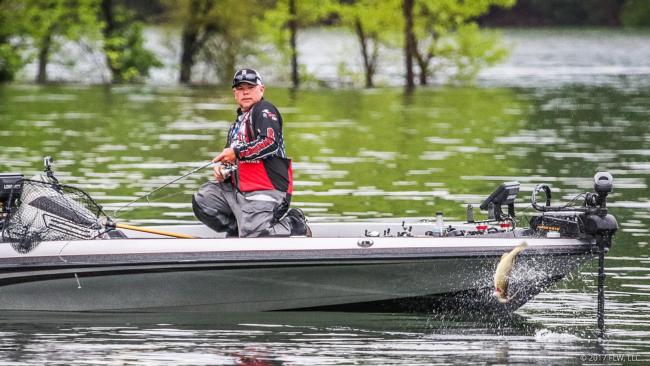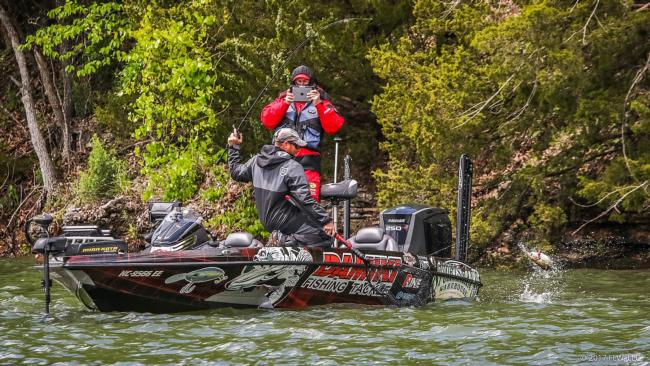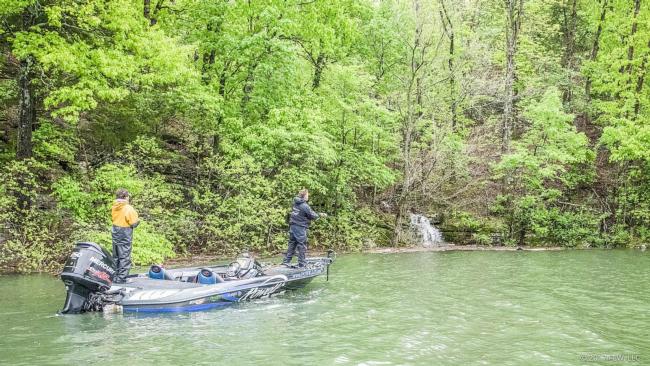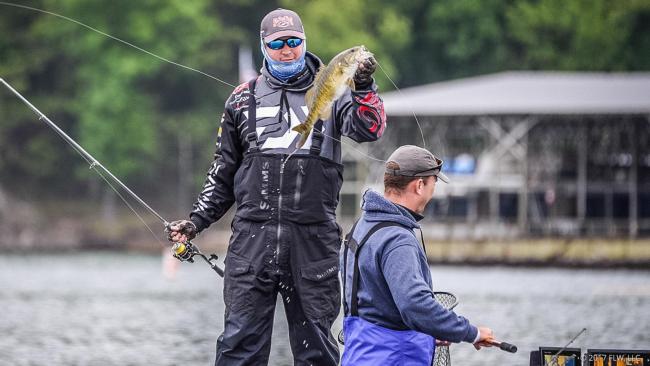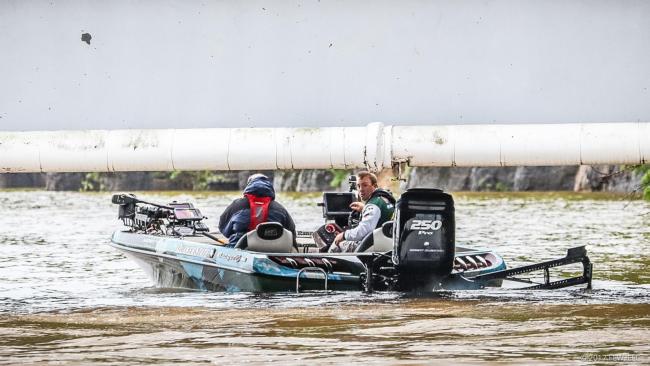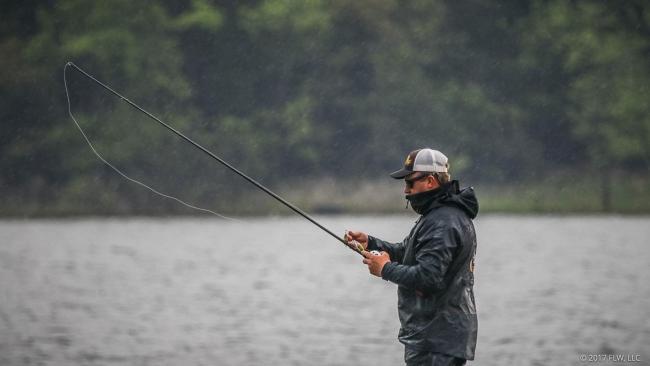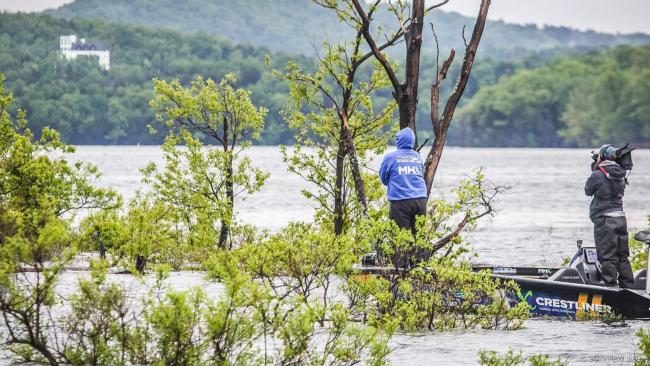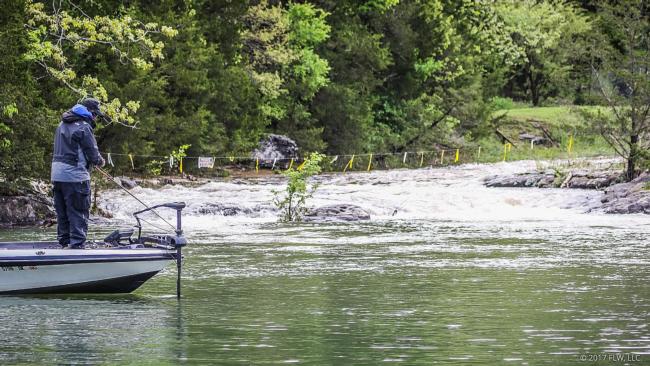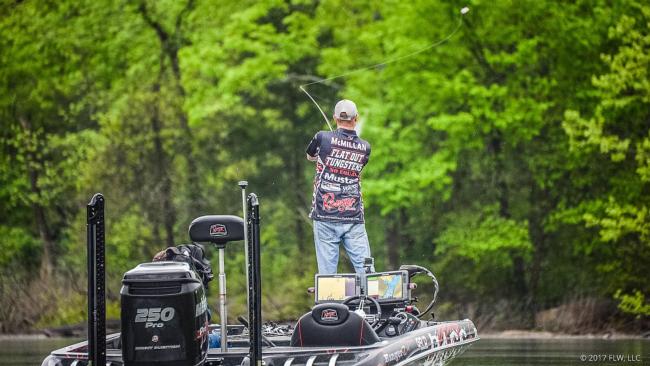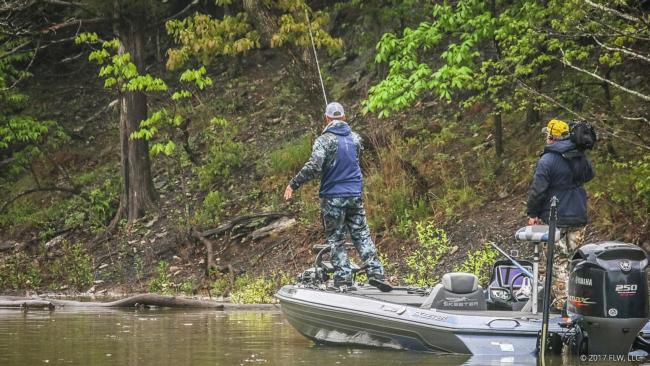Top 10 Patterns from Beaver Lake
Shallow fishing was most effective, but a little bit of everything worked
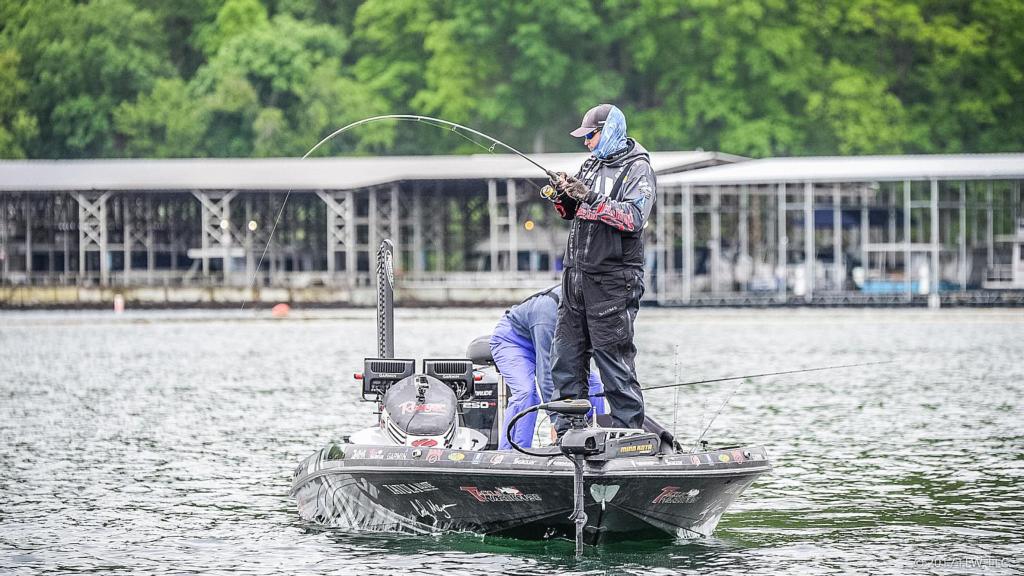
From the start of practice to the end of the FLW Tour event presented by General Tire at Beaver Lake, anglers saw everything from sunshine and bedding bass to flash floods, thunderstorms and finally windy, post-frontal conditions that resulted in only two limits being caught on the last day. Oh, and the water jumped up by about 12 feet while the Tour was in town. It was one of the most unstable, unpredictable weeks on a lake that has developed a reputation for instability in the springtime.
Johnny McCombs found the most reliable pattern amid the changes and walked away a champion by fishing a buzzbait/toad combo around clean banks in the mid-lake area.
Patterns among the rest of the top 10 were all over the board. Here’s the rundown.
2. Reyes targets old shoreline, saddle with shaky head
Texan Jason Reyes came up less than 3 pounds shy of his first FLW Tour victory at Beaver Lake, and like McCombs, Reyes was dialed in on a pattern that was pretty consistent all tournament until the final day. He managed only three keepers Sunday for 5 pounds, 2 ounces and a 44-11 total.
The first two day, Reyes mostly flipped a wacky rig or a shaky head to bushes along the “old shoreline” from before the lake’s recent flood.
“I stayed out on the outside because I was catching some quality fish because the cover was still there, and I figured some new fish could come up there,” he says.
On the final two days, he had his best luck fishing a gravel bar on a saddle between a large island near Prairie Creek and a small island that was only visible from above by the tips of a few trees that were still out of the water.
“On the final two days it got enough water on it that it was productive,” he says. “They were running bait up on it. I think today [Sunday] some stripers moved in because there was a striper boat trolling on it.”
After putting two keepers in the box early at the saddle, Reyes fished a few other similar areas, still targeting the old shoreline, and then decided to scrap it all and run to the dam to target smallmouths in areas where he’d fished in previous years. The back-up plan only produced one keeper smallmouth. Looking back, Reyes isn’t sure if it was worth the lost time to try the smallmouth pattern, but his fish near Prairie Creek simply weren’t cooperating.
His go-to baits this week were a Zoom Finesse Worm, Zoom Trick Worm and 5-inch Yamamoto Senko, all in green pumpkin.
3. Thrift makes another top 10, this time targeting smallmouths
Bryan Thrift has turned making a top-10 finish into a routine. He earned his fourth of the season this week by targeting smallmouths on Beaver’s lower end using a 4-inch Damiki Stinger on an open jighead – his version of a Ned rig. On day four, Thrift caught one of only two limits to improve his weight to 43 pounds, 3 ounces. He now leads the Angler of the Year race by 84 points ahead of Scott Canterbury.
Thrift claims he wasn’t targeting a specific type of cover or structure, and there wasn’t a pattern behind his success. He cycled through various banks within a 5-mile section near the dam and caught fish on different stuff each day. There was only one consistent factor.
“I’d catch them at the same depth each day,” he says. “It seemed like they were 8 to 12 feet deep. I went up with the water and stayed at that depth.”
4. Bryan camps in Ventris
California pro Keith Bryan found all that he needed in the Ventris arm of Beaver Lake east of Prairie Creek’s takeoff site and spent nearly his entire tournament there. A final-day limit of 10 pounds, 8 ounces bumped Bryan up from eighth place to fourth, earning him an additional $4,000 for $20,000 total. His four-day weight was 42-14.
Bryan, who did make one fruitless trip up the White River, says his strategy was to key on areas with cleaner water in the middle section of the lake. That’s why he didn’t spend much time in the muddy waters of the White.
Ventris became his haunt because of its size and the variety of cover and bank types scattered throughout a plethora of cuts and pockets, which gave him many options to try as he deciphered the fish amid daily condition changes.
“I had a lot of areas to run around to,” he says. “Some were dirtier, and some cleaner, but it was never really gin clear. There was steep stuff and gradually sloping stuff, but I caught mostly largemouths.
“Every day it changed. One day they’d be on the steep stuff with rock slabs. Then one day I couldn’t get them to bite, so I went to gradually sloping stuff with baseball-sized rock.”
The most consistent part of his fishing approach was to hold the boat in 19 to 26 feet of water and to cast ahead and toward the bank.
“I didn’t have to work it out,” he says. “They were either there or not.”
Bryan fished a drop-shot rig with a green pumpkin Zoom Swamp Crawler with its tail dyed green. He also used a chartreuse and white 1/2-ounce Revenge spinnerbait with double gold willow-leaf blades. Secondary lures included a Heddon Zara Spook, Lobina Rico Suave and 7-inch Osprey line-thru swimbait.
5. Meyer leans on early smallmouth limits
Cody Meyer was the story of the tournament the first two days, but even before the weekend began, the California pro knew his tournament wouldn’t wind up with a fairy tale ending.
He caught 16 pounds, 1 ounce on day one by tapping into a deep smallmouth spot on the lower end of the lake for a limit, then upgrading with a shallow largemouth.
The smallmouth spot is one Meyer has fished in the past, but he didn’t have high hopes for it in this tournament. He says smallies tend to stay where they are when the water rises, and then they can be tough to catch. Meyer was surprised by his limit the first day, then more surprised when the spot churned out another smaller limit the second day.
After securing the second smallie limit, he bounced around to sawdust and logjams in the backs of clear-water creeks on the lower end and managed to cull up with a shallow largemouth once again.
By day three, his hopes rested on the community hole spots in Prairie Creek, where nearly every bass that’s weighed in during a major tournament gets released. Usually, Prairie Creek is good for a few fish and a few bucks for Meyer when the Tour comes to Beaver, but it wasn’t happening this time around. They were either gone, or just not biting.
Meyer left Prairie Creek after less than 15 minutes and ran all over the lower end. He finished up by catching two keepers in Prairie Creek in the afternoon, but his fate was sealed with a small 6-13 limit.
Day four was even tougher, and he finished the tournament with 40-10.
“Today [Sunday] I flipped, fished a spinnerbait, buzzbait and swimbait; fished waterfalls, flooded willows and deep rock,” he says. “I tried everything I could think of and couldn’t get a bite.”
Meyer says he caught most of his smallmouths on a Strike King Rage Swimmer but also fished a drop-shot Strike King Dream Shot, a Strike King Bitsy Tube and a Strike King Rage Bug. The latter, which he flipped up shallow, caught his two kicker largemouths on Thursday and Friday.
6. Canterbury fishes the river, backs up with finesse
Scott Canterbury’s Beaver Lake practice didn’t reveal much until the final day, when he noticed some bass starting to move up to spawning areas. Of course, a ridiculous amount of runoff that reached the lake between the end of practice and day one of the tournament spoiled any hopes of a kick-butt river pattern for the 2016 Beaver Lake champ.
He ran to the river on day one to try and catch fish from flooded buck brush on flat banks. By 10 a.m., he didn’t have a keeper, so Canterbury relocated near the dam and managed a small limit by finesse fishing with a Ned rig.
On the second day, he went back to the lower end and caught one off a bed and four by tossing the Ned rig.
Finally, on day three, Canterbury had had enough of the sissy stick and do-nothing bait. He took a gamble, ran up the river and threw a spinnerbait and flipped a Dirty Jigs Luke Clausen Compact Pitchin’ Jig with a NetBait Paca Chunk. The move produced more than 20 keepers on a flooded roadbed.
What Canterbury didn’t know is that Christopher Brasher fished the exact same area later that day. When the two of them returned on Sunday, neither got a bite. Maybe the school had been fished out, or maybe more high water and post-frontal conditions sent the fish packing. Whatever it was, Canterbury had no choice but to return to the lower reaches (he had to hustle out of the river anyway in order to get under the bridge before rising waters trapped him).
“I tried a little bit of everything today [Sunday] and ended up catching all three of my keepers on a Ned rig,” he says.
He finished the tournament with 39 pounds, 8 ounces.
7. Cox junk-fishes for seventh
Aside from sight-fishing on day one, Florida pro John Cox really didn’t have any pattern on Beaver Lake other than to fish whatever was in front of him that looked good.
“Every day it was a different pattern,” he says. “Yesterday [Saturday] they were in the drains. You could almost call your shot. Today [Sunday], it wasn’t happening. I think the water was too far up.
“I ran some new stuff and some old stuff. Today, everything looked awful. Nothing looked good,” he adds. “When I got bit, it was where I didn’t expect it, so I was never ready for it.”
Cox fished from the Prairie Creek area to the dam using a Dirty Jigs Luke Clausen Compact Pitchin’ Jig, a Dirty Jigs Swim Jig and a Yamamoto Senko. His four-day catch totaled 38 pounds, 7 ounces.
8. Brasher cranks for eighth
Christopher Brasher was the only top-10 finisher to do any real damage with a crankbait.
“I started off wanting to crank and throw a jig, basically on a little current area where water was running in,” he says. “I had one area that was really special, and I caught four good ones the first day.”
The big catch totaled 15 pounds, 11 ounces and had Brasher in second place. One other similar area turned out keeper bass, but for the most part Brasher’s hopes were washed away with the rising waters that made it too challenging to fish the crankbait – a 6th Sense Movement. His jig was a 1/2-ounce model from Black Angel with a brown skirt.
After the water rose, Brasher swapped to a shaky head and spinnerbait. He managed an OK bag on day three from the flooded ramp that he shared with Canterbury, but couldn’t put much together on Sunday and finished with 37-8.
9. McMillan keys on lower end
Brandon McMillan put together a four-day catch of 36 pounds by targeting a few key areas on Beaver’s lower end. He caught fish on a buzzbait, a SPRO frog and a Yo-Zuri topwater, which he threw to schoolers on day three, but those were only secondary baits. His better catches came flipping a 1/2-ounce green pumpkin 4X4 jig or a Zoom Z Craw Jr. with a 3/8-ounce Flat Out Tungsten weight.
“That’s what I was living and dying with,” he says.
McMillan leaned heavily on the flipping program the last day but only brought in one keeper.
“I thought the best way for me to win was for me to flip, so I stuck with that off and on all day,” he says. “Though, I did catch one keeper on a buzzbait.
“With the water coming up, the only two bites I had flipping were in a bare spot between trees where I think one or two were moving up on beds.”
10. Alexander flips wood upriver
The White River area upstream of the Highway 12 bridge has been a winner more than once in recent Tour events at Beaver Lake, but copious amounts of floating debris and muddy, blown-out water either kept most anglers out on day one, or altogether ruined their bites upriver. Texan Dean Alexander is the only one in the top 10 who primarily fished above the bridge. In fact, the only day that he didn’t focus on the area above the bridge was day four, when he worried that rising water would trap him up there.
The resulting day-four scramble resulted in only one keeper for Alexander, who finished the tournament with 34 pounds, 5 ounces.
“I just went bouncing around, trying to get bit any way I could,” he says of his final day on Beaver. “I caught one little fish this morning [Sunday] that was chasing shad, but there was nothing with it.”
Alexander keyed on the dirtier waters of the White River and made the top 10 by flipping wood cover with a blue fleck Zoom Lizard and a Yamamoto Senko. He says there was no predictable pattern for where he fished.
“They [the areas where he caught fish] all looked different, but when you got bit in an area, it was on wood,” he says. “When you got bit in an area, they were few and far between.”
On the final day, Alexander tried to duplicate his flipping success below the bridge, in “chalky” but not muddy water, but the fish hadn’t readjusted from the latest water-level rise.
“The fish weren’t following the water up fast enough,” he says. “It takes them a day or two to adjust. It came up too much overnight. I didn’t have any confidence they’d adjust.”
